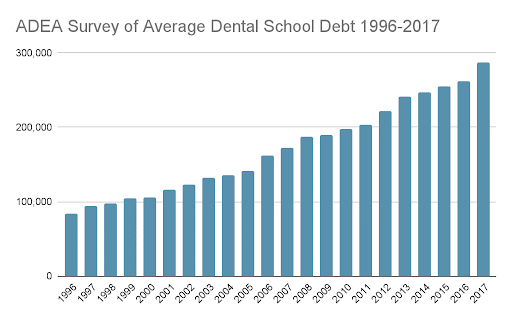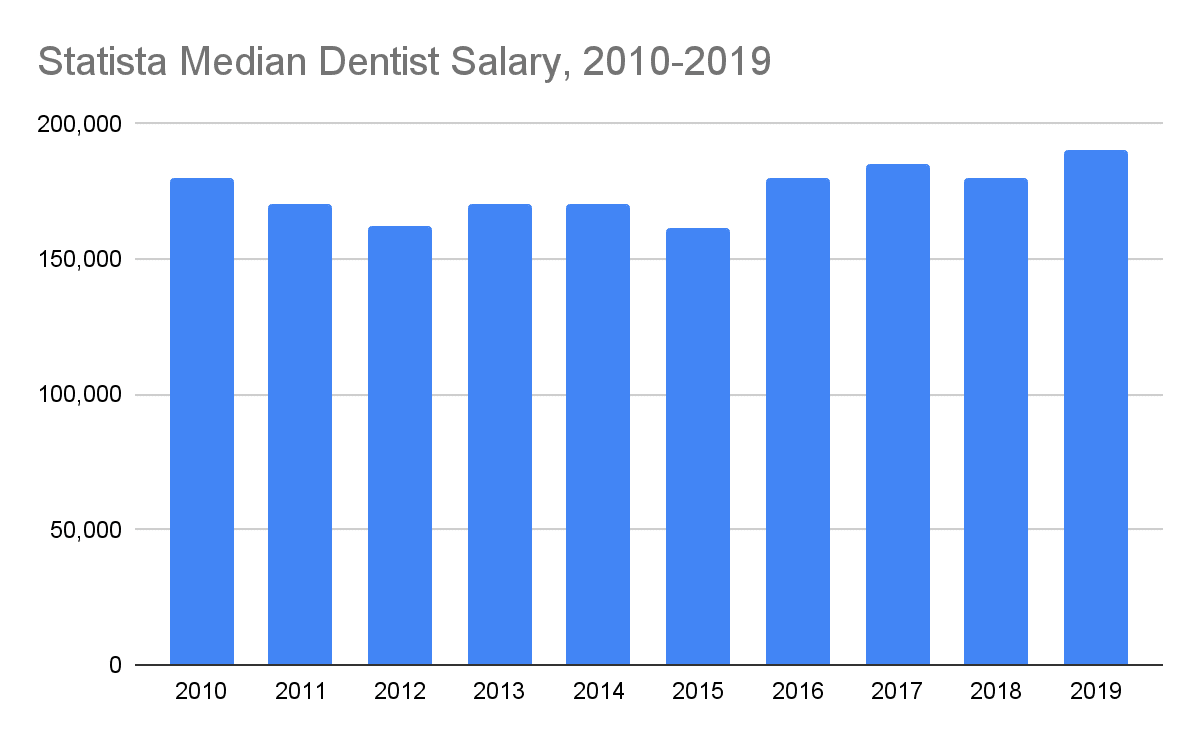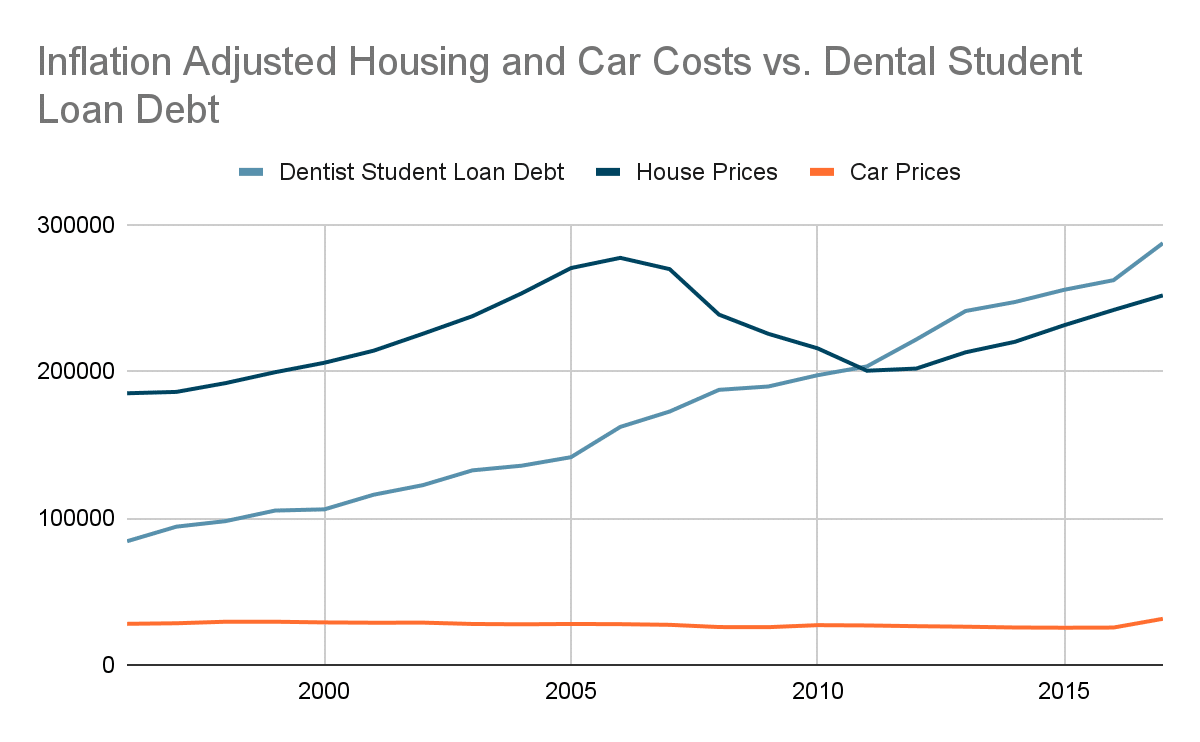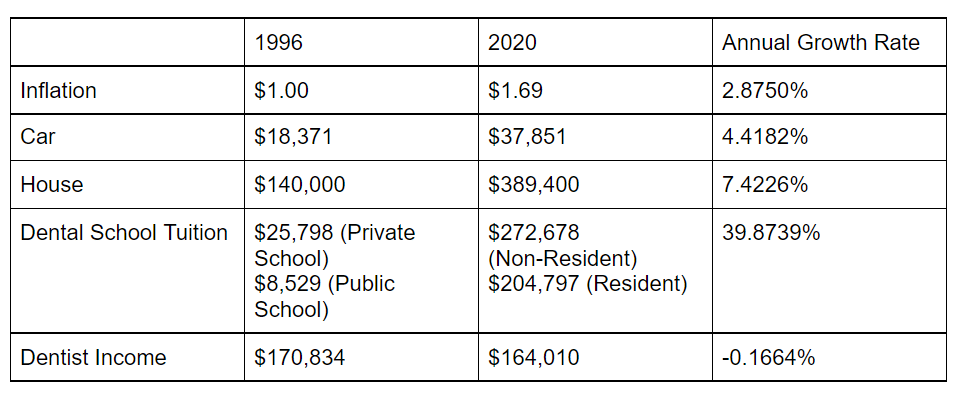Talk with a dentist and you’ll know that graduating from dental school is for those who persevere. The knowledge is immense, the testing is intense, and graduation is a life achievement.
But another mountain is facing these professionals as soon as they receive their diploma. Dentists entering the profession today are straddled with thousands of dollars of student loan debt.
How has dental school loan debt changed over the past thirty years? Let’s take a look at the landscape and give you insight into how to climb the mountain of debt today.
Table of Contents
- Are We Repeating the 1980 Dental School Crisis?
- Current Dental School Costs vs. Salaries
- Is inflation to blame for high dental school debt?
- The Key to Success after Graduate School is Loan Management
Are we repeating the 1980 dental school crisis?
Yes, there was a similar dental school crisis going on in the 1980’s-1990’s. Within four years, between 1978 and 1982, dental school prices doubled.
According to this New York Times article, tuition at the New York University of College Dentistry rose from $6,000 a year in 1978 to $13,547 a year in 1982. In conjunction with the rise of tuition was the increase of interest rates from 3-7% to 9-18%.
A general practitioner dentist graduating in 1982 could expect to make a little under $100,000 a year, according to the American Dental Association Report, The Economics of Dental Education.
By 1997, an ADEA survey of students reported that the average dental school graduate came out of school with $84,247 in debt. Kenneth Redd’s survey found that, “In 1997-1998, student loan funds accounted for nearly 90% of the financial aid received by dental school students”. According to the St. Louis Fed Data, a dentist working between 1990-2000 could make between $80,000-$130,000 each year.
It isn’t new to the dental profession to graduate with the same level of debt as your yearly income. How has dental school loan debt grown in the past thirty years?
Current dental school costs vs. salaries
The current dental school graduate debt-to-income ratio is worse than the 1980 crisis. The ADEA reported that the average 2019 dental student graduates with $292,169 in debt.
The median pay for dentists in 2020 was $164,010 per year, according to the U.S. Bureau of Labor Statistics. Most graduates are coming out of school with twice their yearly income in student loan debt.
Dental school tuition has risen, and risen, and risen again. It has tripled in the past thirty years. Take a look at this graph showing average debt taken by dental graduates, with statistics from the ADEA survey of seniors:
There is a steady rise of tuition for dental school, and this number does not include fees, books, or any of the other costs associated with education.
Are dental incomes rising to meet the level of school debt? Not enough; while debt has tripled, dental salaries have not even doubled the past thirty years. Here is a chart with statistics taken from Statista on the median salaries of dentists from 2010-2019:
While salaries are slowly on the rise, they aren’t keeping up with the cost of education. How does dental school debt compare to the inflation of other life purchases? Let’s look at how the investment of a dental education compares to other life investments over the past thirty years.
Is inflation to blame for high dental school debt?
Dental schools aren’t raising their prices based on normal inflation measures. Using inflation-adjusted prices for housing and car sales, we can see a comparison on how major life expenses compare to the cost of a dental education.
Here is a chart of how house prices, car prices, and dental student loan debt measure against each other from 1996-2017:
Sources: House prices, Car prices here and here, Dental Student Debt
To get a clearer picture of the rise in educational costs for dentists represented by this chart, take a look at this table comparing prices in 1996 and 2021:
While rises are on par with each other for expenses such as a house or car purchase, the annualized growth rate for dental school tuition is extortionate. St. Louis FED, JADA, Bureau of Economic Analysis, Bureau of Labor Statistics, ADA
Dental school debt is the only purchase whose price continues to increase at high levels. Houses and car prices have increased on a level consistent with the rate of inflation growth. This is the mountain for dentists to conquer as they enter their professional careers.
The good news is that while the amount of dental school debt is challenging, it is not insurmountable. With the right team and the right strategy, dentists today can succeed at climbing the mountain of debt.
The key to success after dental school is in loan management
With the right strategy, you can succeed at conquering the hike of debt. You can put “debt free” on your financial plan, and you find achievement at the top of the mountain.
Are you looking into your options to go to dental school? Research and apply to all the scholarships you can. Research your loan options, and choose subsidized direct student loans for as much of your debt as possible.
For many of you, you’ve graduated and are climbing the mountain of debt repayment. Repaying your loans won’t be the quick fix that it was thirty years ago, where in 5-7 years, your income freed you from the expense. It may take longer, but through perseverance and a strategic repayment plan, you could be debt free in 20-25 years.
Public loans often offer forgiveness in the right conditions. Private loans may be eligible for refinancing to lower costs. Income driven repayment plans are available for federal loans. The options and strategy are unique to you.
We know how it feels to be out on the mountain. When you get your team around you, everything is achievable. A quick consult call with an expert team member can put you on the trail to success. Breathe easy and start hiking your mountain today.



